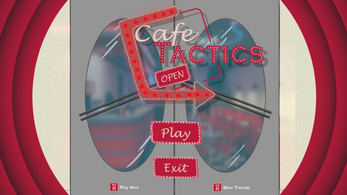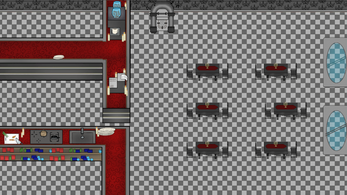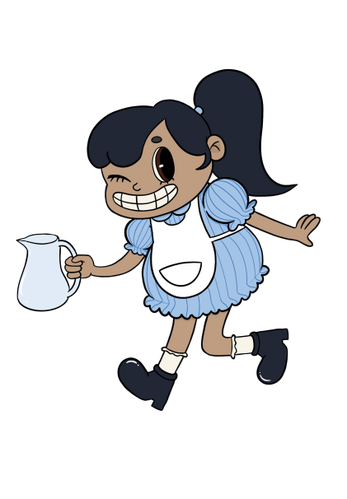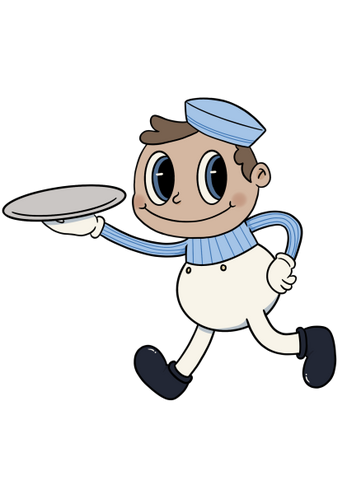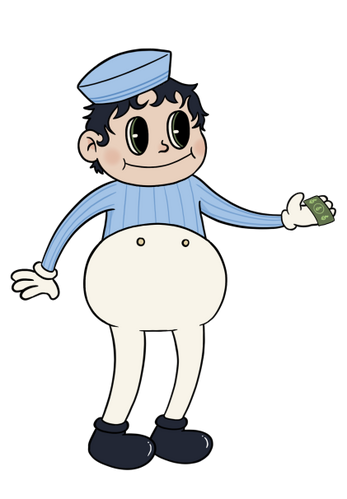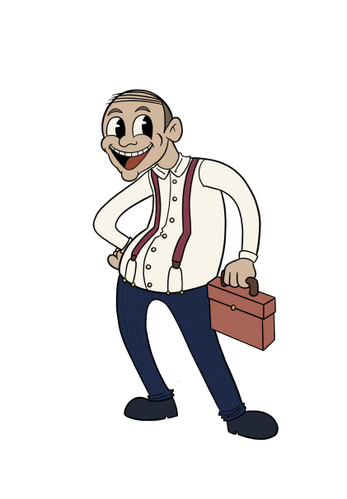
Cafe Tactics
A downloadable game
Game Description
An evil wizard has been turning people into goblins and the only cure is the magic food and drinks served at your café. As the new café manager, it is your job to earn money for your boss, an evil, money-driven nob, and serve as many goblin customers as possible, turning them back into humans.
The stress and chaos of being a café manager are only multiplied as the stakes are increased by your boss on the fly. He wants you to earn him $500 in 10 days time or else, YOU’RE FIRED!
Choose your staff, design the layout of our café, and survive the day running the café. Use any profits gained to hire new staff and buy upgrades for your café, however, your boss is evil and unpredictable and will dip his grubby fingers into the profits!
Can you survive and earn enough money to keep your job?
Blog Posts
Blog 1: Production Plan
Over three meetings our team created our game production plan which included a roadmap split into 4 sprints, a kanban board, a new repository, a risk analysis, and a comprehensive asset and features list. We utilised emerging technology by using AI to assist creating a risk analysis structure that we could use to finalise our risk analysis. We decided it might give us some good ideas to start with as we were having some trouble starting our risk analysis. We also discussed a new narrative which was then added to our Itch.io page. We discussed more robust systems and features and finalised the player progression and win/lose conditions.
Blog 2: Start of Production
While our programmers got busy cleaning up the prototype version of our game and adding new systems, our artists began planning the introduction animations. Our group worked collaboratively to brainstorm different table and wall variations for upgrades that were then created as well as a storyboard for the narrative introduction. We ran into a narrative plot hole after the storyboard was created. We discussed this and came to a conclusion, and this was added to, and clarified in, the game narrative.
Blog 3: Production/Creating first playtesting build
We continued production on our project whilst preparing for a playtesting session. Our aim was to create a build that we could send out for playtesting and create a playtesting plan. We created our playtesting plan with the intent to screen record our testers playthrough whilst recording our testers voice and then ask them some questions. The aim of this play test is to find out if the controls are easy and clear and if the player will know how to play the game without us explicitly telling them how to play.
Blog 4: Playtesting and Implementing Feedback/Bug Fixing
The playtesting session went well, we got some valuable feedback and were able to see how someone who hasn’t worked on the game would play it and how they responded to it. We found some bugs that we spent the week fixing and discussed other elements that we might need to add to the game to make it less confusing and more user friendly. We were happy with the results of our playtesting and the playtesting session as a whole, although, we decided that for our next playtesting session we would make sure to remove the elements of the game that aren’t finished and that we aren’t testing if they are going to confuse our play testers.
Blog 5: Social Media and PR Planning
While we continued to work on our prototype and production, we created a social media and PR Plan, planning to launch the game in week 12. We will use Twitter, YouTube, Instagram, and our blog posts to keep people up to date with our game leading up to the launch and keep in contact with fans. Press releases will be made to give to game journalists and influencers for them to release to their audiences to gain exposer and raise awareness of our game. Three trailers will be released throughout the 6 weeks, the first will be the game reveal trailer, the second will be the gameplay trailer, and the third will be the launch trailer, accompanied by the launch and another press release.
We added the cursor hand this week as we thought it would help the player feel more like the café manager and make it a bit clearer to the player that they are supposed to click around to play the game.
Blog 6: Media Release and Second Playtesting Build
Whilst our artists continued to create food assets and art for the game, our programmers got busy preparing our next playtesting build and fixing some bugs. While this was happening, we created a media release for our game that we would send to influencers to convince them to promote our game. We decided instead of a boring word document, we would make the media release resemble a 1950’s diner menu with artwork and screenshots from the game to really sell the theme of the Café Tactics and make it much more entertaining for an influencer to read.
Blog 7: Playtesting Session #2
Our second playtesting session showed us that the tutorial definitely makes the aim of the game and the narrative a lot clearer for the player. There were some small errors such as spelling mistakes and a lot of suggestions for small things we could add to enhance our game such as certain auditory feedback and being able to click on the customer to deliver an order instead of the waiter as our play tester mentioned that it was their instinct to click the customer. We discussed the feedback from our playtesting and made a list of features to add/fix for our final game build.
Blog 8: Ability Animations and Brainstorming
We continued production on the game, brainstorming and creating concept art for animations for the special abilities. We need animations of the waiter on fire for the ‘swift steps’ ability, all other characters need strong arm animations, and there will be a lighting animation for the barista and a funny angel for abilities that require ‘blessings’ e.g. ‘Brew Masters Blessing’. We made a few minor changes to the current game, e.g. the main menu doors were made transparent so that it was clear that they were doors that led into the café. Our programmers continued to work on the day cycle and the save and load mechanics.
Blog 9: Animating and Money
Our artists got busy animating the ability effects and the walk cycles for the customers and the waiters while our programmers implemented them when completed and continued to work on refining and polishing the gameplay. The font and UI was cleaned up inside Unity and the mechanics involving money and profit margins was implemented so that the player can see how much they are earning during the game, and they are given a money goal for each day and this goal is always visible to them on the screen. This will help the player understand how earning profits is important to the game narrative and for buying upgrades.
Blog 10: Playtesting Session #3
We were very happy with how our third playtesting session went. The players easily understood the gameplay and the narrative. There were a few minor changes that were suggested and discussed, and the play testers experienced a couple small bugs that we were aware of beforehand. One of the biggest things we found during the session were that after the tutorial, the players forget about the docket rail as it is not actually needed to play the game. We discussed this and came up with a solution that would not only require the player to use the docket rail but would possibly make the gameplay smoother and more intuitive. We also found that the rate of the customers spawning for the first day was way too fast and the players were very overwhelmed very quickly, we needed to change this so that the player gets a few days to get used to the game, and so that the difficulty can increase as the days go on without making the game impossible by day 3.
We spent the week implementing the changes we discussed after the playtesting session and finishing up all the art assets so that our programmers could focus on polishing and completing the final mechanics. We also play tested the game within our own team regularly to ensure that it was as polished as possible and that we caught any bugs.
Blog 11: Finalising Game
In preparation for our game submission and presentation next week, we spent this week finishing up all the little programming tasks that we set ourselves throughout the last few weeks after our playtesting session and testing the game ourselves, and finalising any other assets we needed such as a gameplay trailer. The walk cycles for the goblins and the human customers were also completed and implemented in the project. As the art had been completed, the artists were then tasked with continuously testing new updates while our programmers worked tirelessly to get the game running smoothly and as bug free as possible.
Blog 12: The Final Build
We continuously play tested the game all week, finding all the little bugs and finding ways to balance the gameplay, ensuring that the flow of customers was right so that the player isn’t overwhelmed, but also making sure they are receiving enough customers that it is possible to reach the daily goal. This game balancing turned out to be harder than we thought it would as there were so many factors that had to be considered when deciding how many customers the player should receive and how that could be calculated during the game. We ended up with a system that calculates the rate of customers by finding the satisfaction rate from the previous day, this also determines the daily goal, ensuring the rate of customers spawning and the daily goal are connected.
Existing Technologies:
Considering existing technologies, coding techniques and good structure for information to be passed around in games. Within our code base we decided to forgo a few classes we had constructed to handle different item data, in place for scriptable objects. These scriptable objects allowed us to create objects as we needed them loaded with all the necessary data already attached. This reduced the overheard of a number of managing classes and centralised data, meaning there would be no stray references and less room for things to go wrong. We also elected to use Actions & Delegates to trigger specific events that happen along the process of taking food orders and getting them out to the customers. This has helped to make our code a tad cleaner and easier to maintain.
Download Instructions
1. Download the zip and unzip anywhere on your computer
2. Play the "CT_Prototype.exe" file to Play!
(We recommend the Fullscreen version, there is some UI issues with the windowed build)
That's it!
Requirements:
A mouse to point and click
